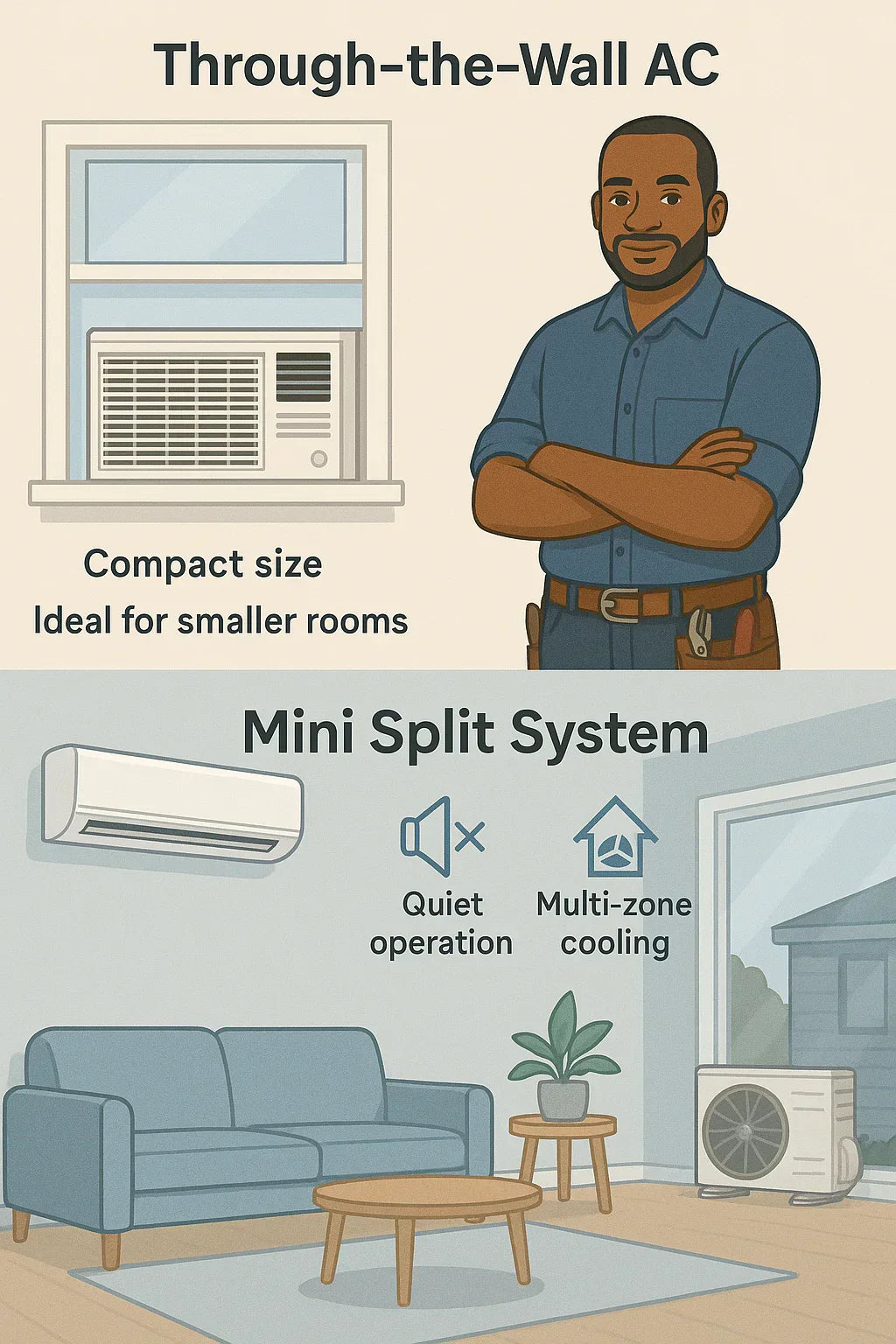🏠 Introduction: Choosing the Right Cooling & Heating Solution for Your Home
Whether you’re cooling a bedroom, finishing a garage, or upgrading an old HVAC setup, chances are you’re considering a through-the-wall air conditioner or a ductless mini split. Both offer year-round comfort with cooling and heating capabilities—without the need for bulky ductwork.
But how do you know which one is right for your space?
This guide breaks down the pros, cons, costs, and performance factors of each system, so practical homeowners like Mark can make the smartest investment.
❓ What’s the Difference Between a Through-the-Wall AC and a Mini Split?
🧱 Through-the-Wall Air Conditioner with Heat Pump
A compact, all-in-one unit mounted through an exterior wall, typically with:
-
Integrated heating (via heat pump or electric coil)
-
No outdoor condenser
-
Ideal for single-room use
🛠️ Example: Amana 9,200 BTU Through-the-Wall AC with Heat Pump
❄️ Ductless Mini Split System
A two-part system:
-
Indoor air handler(s) mounted on the wall
-
Outdoor condenser connected via refrigerant lines
-
Can heat/cool one or multiple zones independently
🔗 Learn more from Energy Star: Ductless Heating & Cooling Systems
📏 Room Size & Use Case: Which Works Where?
| Room Type | Through-the-Wall AC | Mini Split System |
|---|---|---|
| Bedroom (150–350 sq ft) | ✅ Excellent | ✅ Excellent |
| Studio Apartment (300–500 sq ft) | ✅ Good | ✅ Better (zoning optional) |
| Enclosed Porch | ✅ Good | ✅ Excellent (cold climates) |
| Large Living Room (500+ sq ft) | ❌ Limited | ✅ Strong performance |
| Whole Home | ❌ Not practical | ✅ Excellent (multi-zone) |
🔍 Verdict:
-
Choose a through-the-wall unit if you're targeting a single room or small zone and want lower cost.
-
Choose a mini split for multi-room flexibility or larger areas where zoning matters.
💰 Price Breakdown: Upfront, Installation & Long-Term Costs
💵 1. Equipment Cost
-
Through-the-Wall ACs: $600–$1,200
-
Mini Splits: $1,500–$5,000 (multi-zone or high-SEER models can be more)
🛠️ 2. Installation Cost
-
Through-the-Wall: ~$300–$800 (or DIY)
-
Mini Split: $2,000–$5,000+ (requires HVAC pro)
🔗 Mini Split AC Installation Costs
🔄 3. Operating Costs
-
Mini splits typically have higher SEER2 and HSPF2 ratings, making them cheaper to run over time
-
Through-the-wall units are less efficient but consume less energy for small spaces
🔗 U.S. DOE: How Much Will You Save with a Mini Split?
🔇 Noise, Design & Aesthetics
🔊 Indoor Noise
-
Through-the-Wall: 50–60 dB (comparable to a dishwasher)
-
Mini Split: 20–30 dB (whisper quiet)
🖼️ Design Considerations
-
Through-the-wall units are visible but flush with the wall
-
Mini splits are wall-mounted and more modern-looking but protrude into the room
🌬️ Outdoor Components
-
Through-the-wall units have no outdoor condenser
-
Mini splits require outdoor space and noise clearance (40–60 dB)
🔗 Friedrich WallMaster vs. Ductless Comparison
📈 Efficiency & Rebates: Which One Saves More?
🏆 Efficiency Ratings
| Metric | Through-the-Wall | Mini Split |
|---|---|---|
| SEER2 (cooling) | 9–14 | 18–30+ |
| HSPF2 (heating) | 7–9 | 10–13+ |
| ENERGY STAR? | Some models | Most qualify |
🔗 ENERGY STAR: Certified Room ACs
🔗 DSIREUSA: Federal and State HVAC Rebates
💸 Tax Credits
-
Mini splits qualify for federal tax credits up to $2,000 under the Inflation Reduction Act (IRA)
-
Through-the-wall ACs with heat pumps may qualify if ENERGY STAR rated
🧰 Installation: Can You DIY?
🧱 Through-the-Wall Units
✅ DIY-friendly with the right tools
-
Requires wall sleeve, power connection (120V or 230V)
-
No refrigerant handling
❄️ Mini Splits
🚫 Not DIY unless you’re EPA-certified
-
Requires line set, electrical disconnect, vacuum pump, and EPA-licensed installation
-
Improper setup voids warranty
🔗What You Need to Know Before Installing a Mini Split
🧠 Pros & Cons Summary Chart
| Feature | Through-the-Wall AC | Ductless Mini Split |
|---|---|---|
| 🔧 Installation | Easier, DIY-capable | Requires licensed HVAC tech |
| 💰 Cost | Lower upfront and install | Higher upfront, more rebates |
| 🛋️ Room Aesthetics | Compact, flush wall mount | Sleek but protrudes inward |
| 🔇 Indoor Noise Level | Moderate | Whisper quiet |
| ⚡ Energy Efficiency | Moderate | High |
| 🌡️ Year-Round Comfort | Good with heat pump | Excellent with inverter tech |
| 🏠 Best Use Case | Single room | Multi-zone, whole home |
✅ When to Choose Each System
💡 Choose a Through-the-Wall Unit if:
-
You’re cooling one room
-
You want a DIY installation
-
You don’t want outdoor equipment
-
You’re on a limited budget
-
Your climate is mild-to-moderate year-round
💡 Choose a Mini Split if:
-
You’re covering multiple rooms or zones
-
You want higher energy savings over time
-
You live in extreme heat or cold
-
You qualify for rebates or tax credits
-
You’re planning a permanent, long-term upgrade
🛠️ Mark’s Advice: Real-World Takeaway
"If you’re looking to cool or heat a bedroom, office, or bonus room, a through-the-wall unit like the Amana 9,200 BTU model will give you comfort without overcomplicating things. But if you're upgrading a whole floor—or want whisper-quiet, zoned control—the mini split's worth the investment."
In the next topic we will know more about: How Efficient Is the Amana 9,200 BTU Unit? Understanding EER, CEER & Heat Pump Ratings







